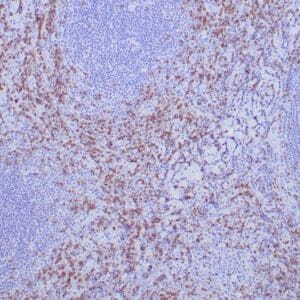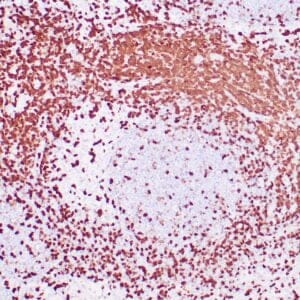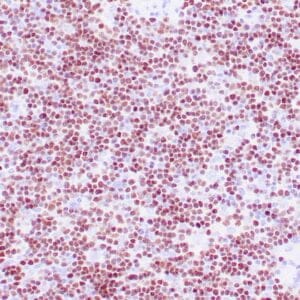| Weight | 1 lbs |
|---|---|
| Dimensions | 9 × 5 × 2 in |
| host | mouse |
| isotype | IgG2b |
| clonality | monoclonal |
| concentration | concentrate, predilute |
| applications | IHC |
| reactivity | human |
| available size | 0.1 mL, 0.5 mL, 1 mL concentrated, 7 mL prediluted |
mouse anti-CD61 monoclonal antibody (ZM33) 6105
Price range: $160.00 through $528.00
Antibody summary
- Mouse monoclonal to CD61
- Suitable for: Immunohistochemistry (formalin-fixed, paraffin-embedded tissues)
- Reacts with: Human
- Isotype:IgG2b
- Control: Bone marrow or tonsil
- Visualization: Cell membrane/cytoplasmic
- 0.1, 0.5, 1.0 mL concentrated, 7 mL prediluted
mouse anti-CD61 monoclonal antibody ZM33 6105
| target relevance |
|---|
| Protein names Integrin beta-3 (Platelet membrane glycoprotein IIIa) (GPIIIa) (CD antigen CD61) |
| Gene names ITGB3,ITGB3 GP3A |
| Protein family Integrin beta chain family |
| Mass 87058Da |
| Function FUNCTION: Integrin alpha-V/beta-3 (ITGAV:ITGB3) is a receptor for cytotactin, fibronectin, laminin, matrix metalloproteinase-2, osteopontin, osteomodulin, prothrombin, thrombospondin, vitronectin and von Willebrand factor. Integrin alpha-IIb/beta-3 (ITGA2B:ITGB3) is a receptor for fibronectin, fibrinogen, plasminogen, prothrombin, thrombospondin and vitronectin. Integrins alpha-IIb/beta-3 and alpha-V/beta-3 recognize the sequence R-G-D in a wide array of ligands. Integrin alpha-IIb/beta-3 recognizes the sequence H-H-L-G-G-G-A-K-Q-A-G-D-V in fibrinogen gamma chain (By similarity). Following activation integrin alpha-IIb/beta-3 brings about platelet/platelet interaction through binding of soluble fibrinogen (PubMed:9111081). This step leads to rapid platelet aggregation which physically plugs ruptured endothelial surface. Fibrinogen binding enhances SELP expression in activated platelets (By similarity). ITGAV:ITGB3 binds to fractalkine (CX3CL1) and acts as its coreceptor in CX3CR1-dependent fractalkine signaling (PubMed:23125415, PubMed:24789099). ITGAV:ITGB3 binds to NRG1 (via EGF domain) and this binding is essential for NRG1-ERBB signaling (PubMed:20682778). ITGAV:ITGB3 binds to FGF1 and this binding is essential for FGF1 signaling (PubMed:18441324). ITGAV:ITGB3 binds to FGF2 and this binding is essential for FGF2 signaling (PubMed:28302677). ITGAV:ITGB3 binds to IGF1 and this binding is essential for IGF1 signaling (PubMed:19578119). ITGAV:ITGB3 binds to IGF2 and this binding is essential for IGF2 signaling (PubMed:28873464). ITGAV:ITGB3 binds to IL1B and this binding is essential for IL1B signaling (PubMed:29030430). ITGAV:ITGB3 binds to PLA2G2A via a site (site 2) which is distinct from the classical ligand-binding site (site 1) and this induces integrin conformational changes and enhanced ligand binding to site 1 (PubMed:18635536, PubMed:25398877). ITGAV:ITGB3 acts as a receptor for fibrillin-1 (FBN1) and mediates R-G-D-dependent cell adhesion to FBN1 (PubMed:12807887). In brain, plays a role in synaptic transmission and plasticity. Involved in the regulation of the serotonin neurotransmission, is required to localize to specific compartments within the synapse the serotonin receptor SLC6A4 and for an appropriate reuptake of serotonin. Controls excitatory synaptic strength by regulating GRIA2-containing AMPAR endocytosis, which affects AMPAR abundance and composition (By similarity). ITGAV:ITGB3 act as a receptor for CD40LG (PubMed:31331973). ITGAV:ITGB3 acts as a receptor for IBSP and promotes cell adhesion and migration to IBSP (PubMed:10640428). {ECO:0000250|UniProtKB:O54890, ECO:0000269|PubMed:10640428, ECO:0000269|PubMed:12807887, ECO:0000269|PubMed:18441324, ECO:0000269|PubMed:18635536, ECO:0000269|PubMed:19578119, ECO:0000269|PubMed:20682778, ECO:0000269|PubMed:23125415, ECO:0000269|PubMed:24789099, ECO:0000269|PubMed:25398877, ECO:0000269|PubMed:28302677, ECO:0000269|PubMed:28873464, ECO:0000269|PubMed:29030430, ECO:0000269|PubMed:31331973, ECO:0000269|PubMed:9111081, ECO:0000269|PubMed:9195946, ECO:0000303|PubMed:16322781, ECO:0000303|PubMed:17635696}.; FUNCTION: (Microbial infection) Integrin ITGAV:ITGB3 acts as a receptor for Herpes virus 8/HHV-8. {ECO:0000269|PubMed:18045938}.; FUNCTION: (Microbial infection) Integrin ITGAV:ITGB3 acts as a receptor for Coxsackievirus A9. {ECO:0000269|PubMed:7519807}.; FUNCTION: (Microbial infection) Acts as a receptor for Hantaan virus. {ECO:0000269|PubMed:9618541}.; FUNCTION: (Microbial infection) Integrin ITGAV:ITGB3 acts as a receptor for Cytomegalovirus/HHV-5. {ECO:0000269|PubMed:15834425}.; FUNCTION: (Microbial infection) Integrin ITGA5:ITGB3 acts as a receptor for Human metapneumovirus. {ECO:0000269|PubMed:24478423}.; FUNCTION: (Microbial infection) Integrin ITGAV:ITGB3 acts aP05556s a receptor for Human parechovirus 1. {ECO:0000269|PubMed:11160695}.; FUNCTION: (Microbial infection) Integrin ITGAV:ITGB3 acts as a receptor for West nile virus. {ECO:0000269|PubMed:23658209}.; FUNCTION: (Microbial infection) In case of HIV-1 infection, the interaction with extracellular viral Tat protein seems to enhance angiogenesis in Kaposi's sarcoma lesions. {ECO:0000269|PubMed:10397733}. |
| Subellular location SUBCELLULAR LOCATION: Cell membrane {ECO:0000269|PubMed:20020534, ECO:0000269|PubMed:20702409, ECO:0000269|PubMed:9195946}; Single-pass type I membrane protein {ECO:0000269|PubMed:20020534, ECO:0000269|PubMed:20702409, ECO:0000269|PubMed:9195946}. Cell projection, lamellipodium membrane {ECO:0000269|PubMed:20702409}. Cell junction, focal adhesion {ECO:0000269|PubMed:20702409, ECO:0000269|PubMed:35687021}. Postsynaptic cell membrane {ECO:0000250|UniProtKB:O54890}; Single-pass type I membrane protein {ECO:0000250|UniProtKB:O54890}. Synapse {ECO:0000250|UniProtKB:O54890}. |
| Tissues TISSUE SPECIFICITY: Isoform beta-3A and isoform beta-3C are widely expressed. Isoform beta-3A is specifically expressed in osteoblast cells; isoform beta-3C is specifically expressed in prostate and testis. |
| Structure SUBUNIT: Heterodimer of an alpha and a beta subunit. Beta-3 (ITGB3) associates with either alpha-IIb (ITGA2B) or alpha-V (ITGAV). Isoform Beta-3C interacts with FLNB. Interacts with COMP. Interacts with PDIA6 following platelet stimulation. Interacts with SYK; upon activation by ITGB3 promotes platelet adhesion. Interacts with MYO10. Interacts with DAB2. Interacts with FERMT2. Interacts with EMP2; regulates the levels of the heterodimer ITGA5:ITGB3 integrin expression on the plasma membrane (PubMed:16216233). Integrin ITGAV:ITGB3 interacts with FBLN5 (via N-terminus) (By similarity). ITGAV:ITGB3 interacts with CCN3 (PubMed:12695522). ITGAV:ITGB3 and ITGA2B:ITGB3 interact with SELP (via C-type lectin domain); the interaction mediates cell-cell interaction and adhesion (PubMed:37184585). ITGAV:ITGB3 is found in a ternary complex with CX3CR1 and CX3CL1 (PubMed:23125415). ITGAV:ITGB3 is found in a ternary complex with NRG1 and ERBB3 (PubMed:20682778). ITGAV:ITGB3 is found in a ternary complex with FGF1 and FGFR1 (PubMed:18441324). ITGAV:ITGB3 interacts with FGF2; it is likely that FGF2 can simultaneously bind ITGAV:ITGB3 and FGF receptors (PubMed:28302677). ITGAV:ITGB3 binds to IL1B (PubMed:29030430). ITGAV:ITGB3 is found in a ternary complex with IGF1 and IGF1R (PubMed:19578119). ITGAV:ITGB3 interacts with IGF2 (PubMed:28873464). ITGAV:ITGB3 interacts with FBN1 (PubMed:12807887). ITGAV:ITGB3 interacts with CD9, CD81 and CD151 (via second extracellular domain) (PubMed:27993971). Interacts (via the allosteric site (site 2)) with CXCL12 in a CXCR4-independent manner (PubMed:29301984). Interacts with MXRA8/DICAM; the interaction inhibits ITGAV:ITGB3 heterodimer formation (PubMed:22492581). ITGAV:ITGB3 interacts with PTN (PubMed:19141530). Forms a complex with PTPRZ1 and PTN that stimulates endothelial cell migration through ITGB3 Tyr-773 phosphorylation (PubMed:19141530). ITGAV:ITGB3 interacts with SLC6A4. Interacts with SLC6A4 (via C-terminus); this interaction regulates SLC6A4 trafficking (By similarity). ITGA2B:ITGB3 interacts with PPIA/CYPA; the interaction is ROS and PPIase activity-dependent and is increased in the presence of thrombin (By similarity). Interacts with tensin TNS3; TNS3 also interacts with PEAK1, thus acting as an adapter molecule to bridge the association of PEAK1 with ITGB3 (PubMed:35687021). Interacts with TM4SF19 (PubMed:38016540). {ECO:0000250|UniProtKB:O54890, ECO:0000250|UniProtKB:Q8R2H2, ECO:0000269|PubMed:11807098, ECO:0000269|PubMed:11940607, ECO:0000269|PubMed:12695522, ECO:0000269|PubMed:12807887, ECO:0000269|PubMed:15156152, ECO:0000269|PubMed:15466936, ECO:0000269|PubMed:16051604, ECO:0000269|PubMed:16216233, ECO:0000269|PubMed:17583734, ECO:0000269|PubMed:18441324, ECO:0000269|PubMed:19141530, ECO:0000269|PubMed:19578119, ECO:0000269|PubMed:20682778, ECO:0000269|PubMed:20702409, ECO:0000269|PubMed:22492581, ECO:0000269|PubMed:23125415, ECO:0000269|PubMed:27993971, ECO:0000269|PubMed:28302677, ECO:0000269|PubMed:28873464, ECO:0000269|PubMed:29030430, ECO:0000269|PubMed:29301984, ECO:0000269|PubMed:35687021, ECO:0000269|PubMed:37184585, ECO:0000269|PubMed:38016540}.; SUBUNIT: (Microbial infection) Integrin ITGAV:ITGB3 interacts with herpes virus 8/HHV-8 glycoprotein B. {ECO:0000269|PubMed:18045938}.; SUBUNIT: (Microbial infection) Integrin ITGAV:ITGB3 interacts with coxsackievirus A9 capsid proteins. {ECO:0000269|PubMed:7519807}.; SUBUNIT: (Microbial infection) Interacts with Hantaan virus glycoprotein G. {ECO:0000269|PubMed:9618541}.; SUBUNIT: (Microbial infection) Integrin ITGAV:ITGB3 interacts with cytomegalovirus/HHV-5 gH:gL proteins. {ECO:0000269|PubMed:15834425}.; SUBUNIT: (Microbial infection) Integrin ITGA5:ITGB3 interacts with human metapneumovirus fusion protein. {ECO:0000269|PubMed:24478423}.; SUBUNIT: (Microbial infection) Integrin ITGAV:ITGB3 interacts with human parechovirus 1 capsid proteins. {ECO:0000269|PubMed:11160695}.; SUBUNIT: (Microbial infection) Integrin ITGAV:ITGB3 interacts with west nile virus envelope protein E. {ECO:0000269|PubMed:23658209}.; SUBUNIT: (Microbial infection) Interacts with HIV-1 Tat (PubMed:10397733). ITGAV:ITGB3 interacts with AGRA2 (PubMed:16982628). {ECO:0000269|PubMed:10397733, ECO:0000269|PubMed:16982628}. |
| Post-translational modification PTM: Phosphorylated on tyrosine residues in response to thrombin-induced platelet aggregation. Probably involved in outside-in signaling. A peptide (AA 740-762) is capable of binding GRB2 only when both Tyr-773 and Tyr-785 are phosphorylated. Phosphorylation of Thr-779 inhibits SHC binding. {ECO:0000269|PubMed:10896934}. |
| Domain DOMAIN: The VWFA domain (or beta I domain) contains three cation-binding sites: the ligand-associated metal ion-binding site (LIMBS or SyMBS), the metal ion-dependent adhesion site (MIDAS), and the adjacent MIDAS site (ADMIDAS). This domain is also part of the ligand-binding site. {ECO:0000269|PubMed:15378069, ECO:0000269|PubMed:19111664}. |
| Involvement in disease DISEASE: Glanzmann thrombasthenia 2 (GT2) [MIM:619267]: A form of Glanzmann thrombasthenia, a disorder characterized by failure of platelet aggregation, absent or diminished clot retraction, and mucocutaneous bleeding of mild-to-moderate severity. Glanzmann thrombasthenia has been classified into clinical types I and II. In type I, platelets show absence of glycoprotein IIb-IIIa complexes at their surface and lack fibrinogen and clot retraction capability. In type II, the platelets express glycoprotein IIb-IIIa complexes at reduced levels, have detectable amounts of fibrinogen, and have low or moderate clot retraction capability. {ECO:0000269|PubMed:10233432, ECO:0000269|PubMed:11588040, ECO:0000269|PubMed:11897046, ECO:0000269|PubMed:12083483, ECO:0000269|PubMed:12353082, ECO:0000269|PubMed:1371279, ECO:0000269|PubMed:1438206, ECO:0000269|PubMed:15583747, ECO:0000269|PubMed:15634267, ECO:0000269|PubMed:15748237, ECO:0000269|PubMed:1602006, ECO:0000269|PubMed:20020534, ECO:0000269|PubMed:2392682, ECO:0000269|PubMed:29084015, ECO:0000269|PubMed:8781422, ECO:0000269|PubMed:9215749, ECO:0000269|PubMed:9376589, ECO:0000269|PubMed:9684783, ECO:0000269|PubMed:9790984}. Note=The disease is caused by variants affecting the gene represented in this entry.; DISEASE: Bleeding disorder, platelet-type, 24 (BDPLT24) [MIM:619271]: An autosomal dominant disorder of platelet production characterized by congenital macrothrombocytopenia and platelet anisocytosis. Affected individuals may have no or only mildly increased bleeding tendency. {ECO:0000269|PubMed:18065693, ECO:0000269|PubMed:29380037}. Note=The disease is caused by variants affecting the gene represented in this entry. |
| Target Relevance information above includes information from UniProt accession: P05106 |
| The UniProt Consortium |
Data
 |
| Human bone marrow stained with anti-CD61 antibody using peroxidase-conjugate and DAB chromogen. Note the cytoplasmic staining of megakaryocytes. |
Publications
| pmid | title | authors | citation |
|---|---|---|---|
| We haven't added any publications to our database yet. | |||
Protocols
| relevant to this product |
|---|
| IHC |
Documents
| # | SDS | Certificate | |
|---|---|---|---|
| Please enter your product and batch number here to retrieve product datasheet, SDS, and QC information. | |||
Only logged in customers who have purchased this product may leave a review.















Reviews
There are no reviews yet.